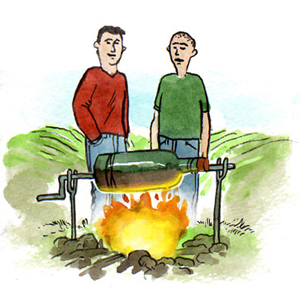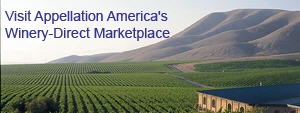

Okay, so wine is not exactly cooked but rising alcohol levels definitely make it hot and many U.S. consumers like it that way.
Some Like It Hot
Technology Columnist Clark Smith weighs in on the evolution of high alcohol -‘hot’ - wines and why they are the rule, not the exception in the U.S.
by
Clark Smith
September 10, 2007
Reader Comments... [12]
Lamborn Family Vineyards, Howell Mountain, Napa, CA
redwinebuzz.com, CA
Maui, HI
http://shirazshiraz.blogspot.com/
Southern Oregon University, Ashland, OR
Wine For All, Katonah, NY
Sonoma, CA
redwinebuzz.com, California
www.bighousewine.blogspot.com, Houston, TX
Nalle Winery, Healdsburg, CA
Marichel Vineyard, Naramata, B.C.
Bunter Spring Winery, Watsonville, CA
[1]
Mike Lamborn Lamborn Family Vineyards, Howell Mountain, Napa, CA
A hardy welcome to Clark Smith! Right out of the gates with a Grand Slam article...spot on !
Many thanks,
Mike
Many thanks,
Mike
[2]
Arthur redwinebuzz.com, CA
Very good piece! An informative and educational look at the shape of things. I find it a poignant observation that a country's wine reflects a nation's culture and values.
[3]
Jim Powlan Maui, HI
Terrific article. I agree on almost all points but still feel Great Wines should neither be acidified, chapeltized nor de-alcoholized. At the same time I separate wines into ‘important wines’ and ‘wines for the backyard BBQ or everyday table’ and believe wine on the table should not over power the food.
[4]
Mike, Blogger http://shirazshiraz.blogspot.com/
Ah yes, what is old is all of a sudden new again. Europeans were accusing Australia of making high alcohol (26% proof, around 15% by volume) wines 100 years ago. The reasons may be different (then it was an incomplete understanding of fermentation, now it’s more aimed at consumer demand for fruit and flavor in wine) but in the end they reconfirm that different climates are more suited to making different wine styles. Oh the terror of it, and yes I did spell terror correctly.
[5]
Greg Jones, Professor, Climatologist Southern Oregon University, Ashland, OR
Great article! However, while there are clearly numerous influences contributing to the higher alcohol wines of today, one must recognize the effect of climate. Contrary to the statement "In fact, the rising heat of the Central Valley is pulling in more ocean air, rendering the South Valley cooler, not warmer." I have not seen any evidence of this happening. As a matter of fact, I did a study on the two longest climate stations in the Napa Valley -- St. Helena and the Napa St. Hospital -- and the results show that the entire valley has warmed with slight differences from the cooler southern end to the warmer northern end, but not significant enough to matter. The average warming from 1930-2004 has been over 600 degree-days with the average growing season warming 2.9 deg F with most of the warming coming at night (5.3 deg F). The result has been a much warmer and longer growing season, nearly 90 days longer from the median first and last frosts since 1930. You can't tell me that this has not had an impact on growing grapes in Napa. Also note that these trends are consistent across the west coast of the US and parallel those observed in Europe and Australia.
So while we have a very complex system that is ultimately driven by the pocket books of wine consumers, I seriously doubt that the wines of today could have been made in the climates of the middle of the last century. I for one do not buy wines over 14% alcohol and I do not know anyone who purposely goes out and drinks them. Maybe there will be enough of us to allow winemakers to continue making interesting, balanced wines and still make money.
So while we have a very complex system that is ultimately driven by the pocket books of wine consumers, I seriously doubt that the wines of today could have been made in the climates of the middle of the last century. I for one do not buy wines over 14% alcohol and I do not know anyone who purposely goes out and drinks them. Maybe there will be enough of us to allow winemakers to continue making interesting, balanced wines and still make money.
[6]
Tish Wine For All, Katonah, NY
Excellent overview, Clark, with plenty of science and history. But have you let the wine media off the hook? After years of Robert Parker's avowed preference for "hedonistic" wines, and James Laube's penchant for giving higher scores to big Cabs over more elegant reds, surely wineries themselves are leaning toward more ripeness and alcohol at least in part to garner higher ratings. Granted, I have not done a statistical analysis, but just scan the ranks of the Wine Spectator's and Wine Advocate's highest-scored wines and you will find a heap of alcohol too. Tyranny of numbers has to be considered in this discussion.
[7]
Alan Wastell Sonoma, CA
Another party heard from in the high(er) alcohol wine debate. Clark Smith gives a fairly complete overview of the rise of alcohol levels in our table wines and offers something of a defense of his de-alc solution. This probably won't appease the detractors such as Mr. Corti and Mr. Dunn who seem to feel that they are on a moral (and morally superior) crusade against the evils of ripeness rather than simply arguing for a style of wine that they personally prefer. I enjoy wines of many styles; when I put down bottles of 1981 Cabernet Sauvignon for my daughter's birth year, I chose Dunn's Howell Mountain Cabernet. It tasted pretty darn good on my daughters 21st birthday... I enthusiastically enjoy Alsace (or Mendocino or Russian River) whites and Spanish and Italian reds at moderate alcohol levels. But when it's insinuated that people who drink a California wine that is over 14.5% alcohol are somehow unsophisticated (or stupid), I really have to object. Wonderful wines come in all colors (white, red , pink), from all parts of the globe and from both sides of that arbitrary alcohol figure. I also drink and enjoy Zinfandels (and, yes, Chardonnays) that clock in north of 14.5%. From good vineyard sources and good producers they are neither undrinkable nor hot, I do drink them with food and yes Mr. Corti, we do finish a bottle and wish there was a little bit more...There are always people willing to tell you what you should like in this world, from music to literature to food and wine; let's all just pay attention to what we personally enjoy and spend less time worrying that the rest of the world isn't smart enough to agree with us...
[8]
Arthur, Founder redwinebuzz.com, California
Greg [comment #5], I am curious if there is a difference in temperatures in the 1970s and in the current decade. I am curious if you saw any effect of the pollution laws that came into effect in the 1970s.While I am not disputing climate change, I see hot, over-extracted wines being made from adjacent blocks of the same vineyard in the same years as much more composed, higher acid wines. This is absolutely a result of the differences in growing and picking. Thus, I am not inclined to chalk this style of wine to climate change. A number of things have changed in the way vineyards and vines are farmed since the mid-1900. This contributes to the style of wines as well.
[9]
Tom Casagrande, wine lover/blogger www.bighousewine.blogspot.com, Houston, TX
The article, which was interesting, stated this in passing: "Together [Conetech and Vinovation] take an average of over 1 percent alcohol from 45 percent of the California wines you buy." That is staggering. But what is worse is that no winery I know of will disclose on its label whether the wine in the bottle was subjected to post-fermentation de-alcoholizing. If the wineries don't want to do it, there's a reason. Lots of wine drinkers (like me) would shun such wines if they knew. There's also a fix. If the wineries won't tell the truth, then either the federal or California government should require them to. I don't normally advocate more government intervention, but if the industry won't disclose this voluntarily -- which to me is barely one step removed from false advertising -- what choice do concerned consumers have but to ask the government to force them to do so? I seek out naturally made, unmanipulated wine, but that's become almost impossible to do in California. And it's darn frustrating.
[10]
Doug Nalle, Owner and winmaker Nalle Winery, Healdsburg, CA
Nice going, Clark. A great synopsis with hope to boot. My wife and I enjoyed a bottle of 1996 Nalle Zinfandel tonight. In its prime and 13.5% alcohol. Reminded us of a classy Barolo. A little nasty on release, and pretty much panned by the press sandwiched between the lush '95 and '97 vintages, I begged people to hang on. Tonight I feel VIN-dicated.
~ Doug
~ Doug
[11]
Richard Roskell, Winemaker Marichel Vineyard, Naramata, B.C.
Great article drawing on many aspects of the reasons for higher alcohol wines. The comments were likewise interesting. I'm in agreement with Clark that having a high-alcohol wine does not preclude elegance. As it so often is, balance is key. You're not going to have an easy time balancing high alcohol without sufficient acidity. And this may be one reason why high alcohol is sometimes associated with a sort of flabbiness in the wine: high sugar content in the originating fruit often goes hand-in-hand with lower acidity. I'm not proposing that a Big Bomb is the right wine for every occasion or every food. Are you going to overshadow a delicate plate with a powerful wine? No. But there are times when a big wine seems like just the ticket. And so why shouldn't we be making them - and making them right? You can dial it down to the austere and have a Catherine Deneuve. You can go to the other extreme and have a Pamela Anderson. With all respect to those two beautiful women, perhaps the ideal in wine lies somewhere in between.
[12]
Mark Bunter, owner Bunter Spring Winery, Watsonville, CA
Clark,
Wow. Thanks for the history lesson. You never fail to educate and enlighten, or enrage!
~ Mark
Wow. Thanks for the history lesson. You never fail to educate and enlighten, or enrage!
~ Mark
 READER FEEDBACK: To post your comments on this story,
click here
READER FEEDBACK: To post your comments on this story,
click here





